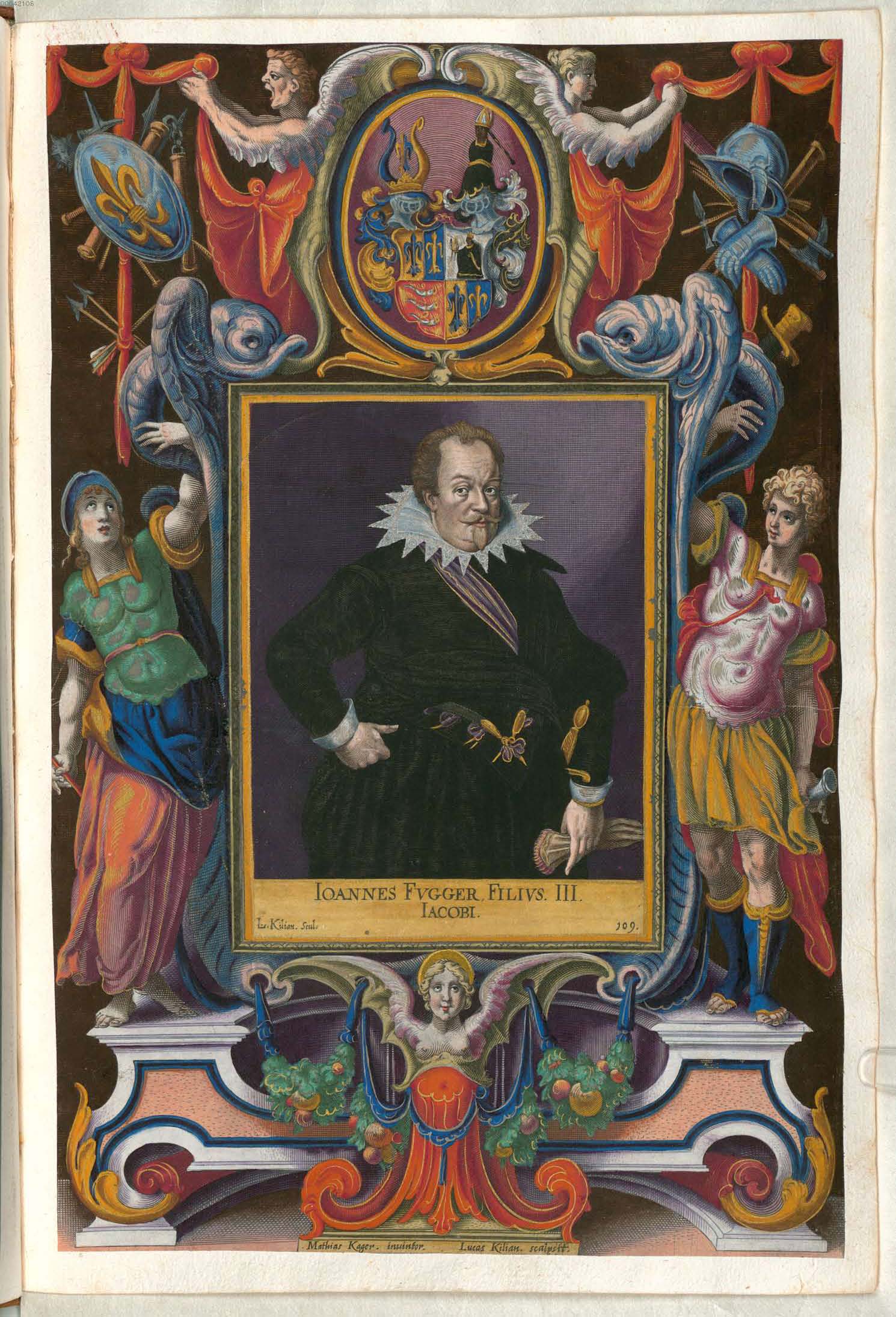|
Johann Fugger The Elder
Johann Fugger the Elder or Hans Fugger (1 June 1583 - 28 April 1633, Telfs) was a German businessman, landowner and noble of the Fugger family. He was Lord of Fuggerschloss Babenhausen, Schloss Babenhausen and Boos, Bavaria, Boos. He was one of the sons of Jakob III. Fugger and his wife Anna Ilsung. After his father's death in 1598, he managed the lordships of Babenhausen and Boos among others. The Fugger lordships were divided up in 1620 and exchanged among the family shortly afterwards. Johann became lord of Boos whilst his brother Maximilian (1587–1629) became lord of Babenhausen, Johann Herr zu Boos. Franz Herre: ''Die Fugger in ihrer Zeit.'' 12. Auflage. Wißner-Verlag, Augsburg 2005, . Marriage and issue In 1605, he married Marie Eleonore, Countess of Hohenzollern (1586-1668), daughter of Charles II, Count of Hohenzollern-Sigmaringen by his first wife. Johann and Marie Eleonore had the following children: * Jakob, count Fugger (1606–1632) * Maria Eleonore, freiherr, frei ... [...More Info...] [...Related Items...] OR: [Wikipedia] [Google] [Baidu] |
Freiherr
(; male, abbreviated as ), (; his wife, abbreviated as , ) and (, his unmarried daughters and maiden aunts) are designations used as titles of nobility in the German-speaking areas of the Holy Roman Empire, the Austro-Hungarian Empire and in its various successor states, including Austria, Prussia, Bavaria, Liechtenstein, Luxembourg, etc. Traditionally, it denotes the titled rank within the nobility above ' (knight) and ' (nobility without a specific title) and below ' ( count or earl). The title superseded the earlier medieval form, '. It corresponds approximately to the English baron in rank. The Duden orthography of the German language references the French nobility title of ''Baron'', deriving from the Latin-Germanic combination ''liber baro'' (which also means "free lord"), as corresponding to the German "Freiherr"; and that ''Baron'' is a corresponding salutation for a ''Freiherr''. Duden; Definition of ''Baron, der'' (in German)/ref> ' in the feudal system The title ... [...More Info...] [...Related Items...] OR: [Wikipedia] [Google] [Baidu] |
People From Unterallgäu
The term "the people" refers to the public or common mass of people of a polity. As such it is a concept of human rights law, international law as well as constitutional law, particularly used for claims of popular sovereignty. In contrast, a people is any plurality of persons considered as a whole. Used in politics and law, the term "a people" refers to the collective or community of an ethnic group or nation. Concepts Legal Chapter One, Article One of the Charter of the United Nations states that "peoples" have the right to self-determination. Though the mere status as peoples and the right to self-determination, as for example in the case of Indigenous peoples (''peoples'', as in all groups of indigenous people, not merely all indigenous persons as in ''indigenous people''), does not automatically provide for independent sovereignty and therefore secession. Indeed, judge Ivor Jennings identified the inherent problems in the right of "peoples" to self-determination, as i ... [...More Info...] [...Related Items...] OR: [Wikipedia] [Google] [Baidu] |
Fugger Family
The House of Fugger () is a German family that was historically a prominent group of European bankers, members of the fifteenth- and sixteenth-century mercantile patrician (post-Roman Europe), patriciate of Augsburg, international mercantile bankers, and venture capitalists. Alongside the Welser, Welser family, the Fugger family controlled much of the European economy in the sixteenth century and accumulated enormous wealth. The Fuggers held a near monopoly on the European copper market. This banking family replaced the House of Medici, Medici family who influenced all of Europe during the Renaissance. The Fuggers took over many of the Medicis' assets and their political power and influence. They were closely affiliated with the House of Habsburg whose rise to world power they financed. Unlike the citizenry of their hometown and most other trading patricians of German free imperial city, free imperial cities, such as the Tucher von Simmelsdorf, Tuchers, they never converted to Lu ... [...More Info...] [...Related Items...] OR: [Wikipedia] [Google] [Baidu] |
1633 Deaths
Events January–March * January 20 – Galileo Galilei, having been summoned to Rome on orders of Pope Urban VIII, leaves for Florence for his journey. His carriage is halted at Ponte a Centino at the border of Tuscany, where he is quarantined for 22 days because of an outbreak of the plague. * February 6 – the formal coronation of Władysław IV Vasa as King of Poland takes place at the cathedral in Kraków. He had been elected as king on November 8. * February 9 – the Duchy of Hesse-Cassel captures Dorsten from the Electorate of Cologne without resistance. * February 13 ** Galileo Galilei arrives in Rome for his trial before the Inquisition. ** Fire engines are used for the first time in England in order to control and extinguish a fire that breaks out at London Bridge, but not before 43 houses are destroyed. "Fires, Great", in ''The Insurance Cyclopeadia: Being an Historical Treasury of Events and Circumstances Connected with the Origin and P ... [...More Info...] [...Related Items...] OR: [Wikipedia] [Google] [Baidu] |
1583 Births
Events January–March * January 1 – The Duchy of Savoy adopts the Gregorian Calendar, replacing the Julian Calendar. * January 18 – François, Duke of Anjou, attacks Antwerp. * February 4 – Gebhard Truchsess von Waldburg, newly converted to Calvinism, formally marries Agnes von Mansfeld-Eisleben, a former canoness of Gerresheim, while retaining his position as Archbishop-Elector of Cologne. * February 7 – In the Netherlands, the Siege of Eindhoven by the Spanish Army begins.Mack P. Holt, ''The Duke of Anjou and the Politique Struggle During the Wars of Religion'' (Cambridge University Press, 2002) p.190 The walled city will fall in April. * March 10 (February 28 O.S.) – The ''Queen Elizabeth's Men'' troupe of actors is founded in England by order of Queen Elizabeth to Edmund Tilney, the royal Master of the Revels. April–June * April 9 – A Burmese Army force of 16,000 men, commanded by Thado Dhamma Yaza II of Prome and ... [...More Info...] [...Related Items...] OR: [Wikipedia] [Google] [Baidu] |
Inzigkofen
Inzigkofen is a municipality in the district of Sigmaringen in Baden-Württemberg in Germany. Historically, it is part of the Swabian north Alpine foreland basin. It consists of three districts: Within Engelswies is the now-abandoned Talsberg quarry, known for its fossiliferous layers, and the site of evidence of the oldest Eurasian hominoids; a molar tooth The molars or molar teeth are large, flat teeth at the back of the mouth. They are more developed in mammals. They are used primarily to grind food during chewing. The name ''molar'' derives from Latin, ''molaris dens'', meaning "millstone toot ... found there in June 1973 was reported in June 2011 to have been "dated with relative precision at 17 to 17.1 Ma" (million years ago). Mayors In November 2004 Bernd Gombold, was elected mayor with 96,8 % of the vote.Hermann-Peter Steinmüller (hps): ''Kompliment vom Landrat.'' In: ''Südkurier'' vom 30. November 2004.Manfred Dieterle-Jöchle (dim): ''Zur Person.'' In ... [...More Info...] [...Related Items...] OR: [Wikipedia] [Google] [Baidu] |
Katharinenkloster Augsburg
St Catharine's Convent in Augsburg, Germany was a community of Dominican Order, Dominican nuns. It was founded in the Am Gries suburb of the city in 1243 before moving into the city centre eight years later. It was dissolved in 1802, and the nuns vacated the monastery in 1807. In 1834, some of the convent buildings were re-used to house the Königliche Polytechnische Schule and a trade school. In 1835, the former convent church was converted into the Staatsgalerie Altdeutscher Meister, a branch of the Bavarian State Painting Collections, which is still there today. Hans Pörnbacher: Maria Königin der Engel. Kunstverlag Josef Fink, Lindenberg 1999, , S. 1. In 1877, the building was taken over by a district primary school, now known as the Holbein-Gymnasium. References [...More Info...] [...Related Items...] OR: [Wikipedia] [Google] [Baidu] |
Kloster Holzen
Holzen Abbey (''Kloster Holzen'') was a convent of Benedictine nuns situated in the village of Holzen (west of the B2 at Nordendorf above the Schmutter) in Allmannshofen in Bavaria, Germany. History The abbey has a rich history dating back to its legendary founding in 1150 by Marquard von Donnersberg as a double monastery for both monks and nuns. However, the monastery for monks was dissolved in 1470 as part of the Melker reform, while the nuns' convent continued to grow and expand. The monastery faced significant challenges during its history, including severe damage during the Peasants' War in 1525 and abandonment in 1632 due to a Swedish invasion. However, the nuns returned in 1647, and in 1696, the foundation stone for the current monastery was laid on the Karlsberg mountain. The monastery was dissolved during the secularization (church property), secularization period but was handed over to the princes of Hohenzollern-Sigmaringen, who allowed the nuns to remain. In 1813, th ... [...More Info...] [...Related Items...] OR: [Wikipedia] [Google] [Baidu] |
Charles II, Count Of Hohenzollern-Sigmaringen
Charles II, Count of Hohenzollern-Sigmaringen (; 1547 – 8 April 1606) became Count of Hohenzollern-Sigmaringen in 1576 and remained so until his death. He was the fifth but second surviving son of Charles I, Count of Hohenzollern, and Anna, daughter of Ernest, Margrave of Baden-Durlach. Life Initially, he was educated in Vienna, and later in Freiburg im Breisgau jointly with his older brother Eitel Friedrich. Later, he assisted to the Aulic Council in Vienna, where his father served as president; there, he gained the trust and friendship of Ferdinand II, Archduke of Further Austria, (son of Holy Roman Emperor Ferdinand I) and went into his service to Tyrol, being able to established good connections with the Holy Roman Empire, which was seen in 1570 when he was appointed Supreme Captain and Governor in Alsace. Two years later, Charles II took over the guardianship of Count Jakob of Geroldseck. Under the rule of his father Charles I the possessions of the county of Zollern ... [...More Info...] [...Related Items...] OR: [Wikipedia] [Google] [Baidu] |
Franz Herre
Franz Herre (born 11 April 1926) is a German biographer, historian and journalist. Life Herre grew up in Augsburg and studied history at the University of Munich, receiving his doctorate in 1949, supervised by Franz Schnabel and with a dissertation on the Augsburg middle-classes during the Age of Enlightenment. He then worked as a journalist on the ''Augsburger Allgemeine'' and ''Rheinischer Merkur'' for several years. From 1962 to 1981 he was editor-in-chief of the Deutsche Welle in Cologne. He now works as a freelance writer in Herrsching am Ammersee. Works Biographies * '' Freiherr vom Stein: sein Leben, seine Zeit'', Köln 1973. * '' Kaiser Franz Joseph von Österreich: sein Leben, seine Zeit'', Köln 1978. * '' Kaiser Wilhelm I.: der letzte Preuße'', Köln 1980. * ''Radetzky: eine Biographie'', Köln 1981. * ''Metternich: Staatsmann des Friedens'', Köln 1983. * ''Moltke: der Mann und sein Jahrhundert'', Stuttgart 1984. * '' Ludwig II. von Bayern: sein Leben – sein Lan ... [...More Info...] [...Related Items...] OR: [Wikipedia] [Google] [Baidu] |





